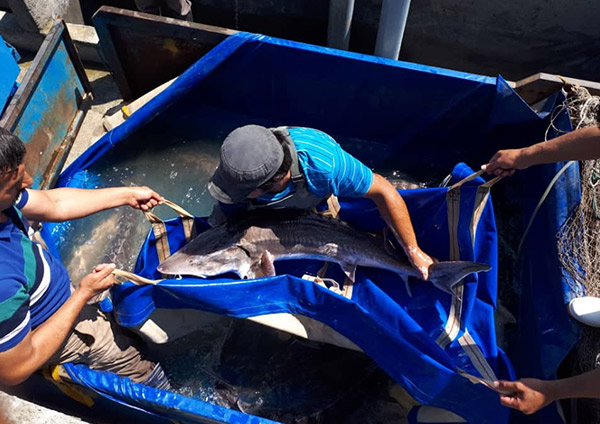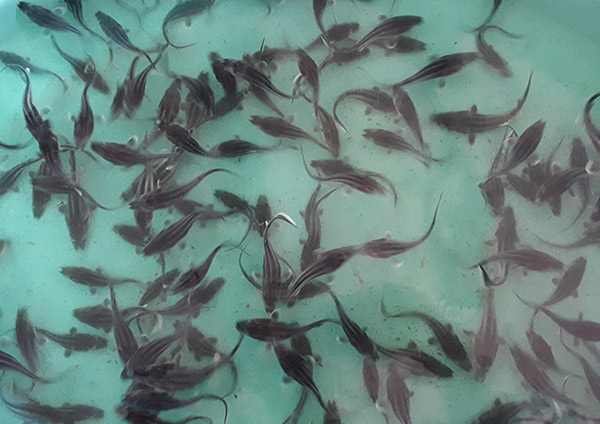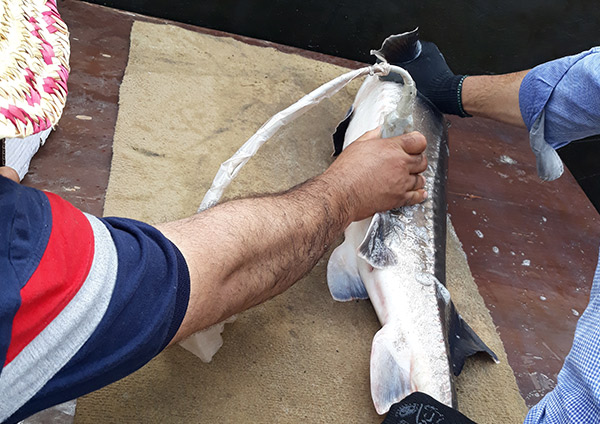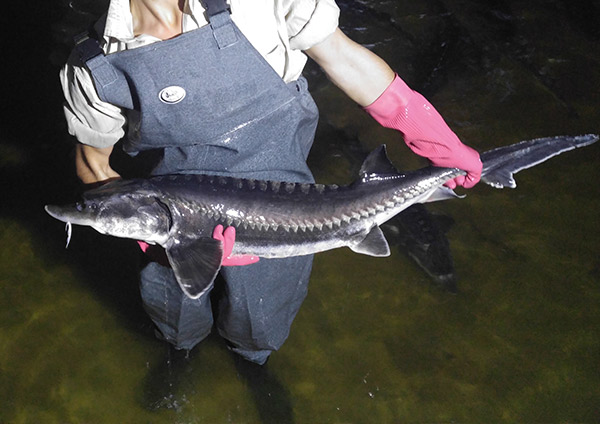caviar
beluga
Morphological, biological and distribution overview
The population growth ratio of every society, including Iran, is significantly lower than that of food production, so that one can claim population growth is geometric in shape and food production growth is linear. Crop production is limited by the need for suitable land and water everywhere, and studies have shown that there are only two ways to increase food production under current global conditions:
One is the application of modern technologies to further exploit agricultural products, livestock, poultry and aquaculture production and the other is the large-scale aquaculture in seas and inland waters, in particular by sea ranching and cage culture in a way that all or some part of the aquaculture food from the water reserves in the water is provided.
Since 1950, world-wide aquaculture has grown dramatically every year and is now competing with the global catch of marine and inland waters. The global average for annual catch in the seas and oceans is 80 million tons and inland waters around 10 million tons and a total of 90 million tons, which is not only impossible to increase further but also due to the increasing human population, these numbers are sliding especially in countries where control is less possible on catch, both in the inland and in free waters.
One of the world’s most valuable aquatic species is the sturgeon, which accounts for over 90 percent of its reserves in the Caspian Sea and its natural catch in the former Soviet waters was about 26,000 tons annually and in Iranian waters about 2,500 tons annually. Their caviar production was 2,500 to 3,000 tons respectively, and about 250 tons or more for Iran.
Such factors as fishing abuse at the time of Islamic Revolution of Iran, the collapse of the Soviet Union, and pollution caused the decline of these valuable reserves in the Caspian Sea, which led IUCN, or the International Union for Conservation of Nature, to declare this fish, meaning the Caspian Sturgeon, an endangered species.
The fishing practice of this species has been halted in the Caspian Sea in recent years, but unfortunately in both Iran and the countries around the Caspian Sea the poachers’ fishing has become more and more common. The former Soviet Union used most of the caviar production from the Caspian Sea for domestic consumption.
In the last two decades farming of some the species of sturgeon have begun to grow. Worldwide production of meat for sturgeon species is currently over 100,000 tons of meat worldwide (J.Applied Ichthyology, vol.35, Issue 1)
In 2017 over 2,329 sturgeon farms in the world has been accounted for, from which 54% of it is in China, 24% in Russia, 8% in the Middle East, 7% in the Far East and 6% in Europe (FAO, 2018)
Sturgeon farming is recently significant and beneficial in Iran however it is so stressful and long-lasting activity. Sturgeons (Acipencers) are a long lived and late maturity fishes that spawn many times in life.
Dating back to 250 million years ago, and since they have been able to survive, they are referred to as living fossils.
In this group of fish there are two families, namely Acipenseridae or sturgeons and Polyodontidae or Paddle fishes. The second type does not exist in Iranian waters. There are 25 species in these two families, 5 of which live in the Caspian Sea, and form the highest density of sturgeon.
In addition to species in the Caspian Sea, there are two other species of sturgeon named Siberian sturgeon and sterlet sturgeon in Russian rivers which have been introduced to Iran for breeding.

Although sturgeons have continued to go towards extinction from the CITES’ point of view and still are considered to be, Iran is currently the main center of breeding of these species to increase the Caspian Sea reserves.
The growth of fish related to factors of genetics and environment. Life cycle of sturgeons is related to age of sextual maturity, right environmental condition such as suitable place of spawning, water temperature, nutrition, not polluting water and etc. human can control these items in culturing farms.
Culturing sturgeons needs high costs for initial investment, high level of knowledge, right place and necessary equipment such as pumps, oxygen injectors, UV sterilization units, mechanical and biological filters, air blowers, heaters, fish tanks and etc., also experienced personnel and having patience for such activities. patience because to get a part of the results of the investment and effort of the breeders who produce caviar for this fish takes from 5 to 10 years.
Lazir Holding by taking into account the existing sensitivities associated with the breeding of these species and in the direction of entrepreneurship and in close coordination with the Iranian Fisheries Organization, specially Mazandaran Fisheries Department for Aquaculture and with the help of its senior experts, has launched a large collection of sites and there by farming of 5 spices of sturgeon (beluga, Persian sturgeon, stellatus, baerii and sterlet) is able to produce 1200 kilos of high quality caviar and 50 tons of sturgeon meat, therefore has been able to take an effective step towards production, and to be recognized as the best producer in the city of Mahmudabad.
We believe that with the growth of sturgeon breeding and supply of baby fish and the production of meat and caviar, there has been considerable service to producing more of these species and trying to get the sturgeon off the endangered list and this in turn is a global service for current and future generations to enjoy sturgeon.
Lazir Agro- industry Complex is currently raising 40,000 fish belonging to different species of sturgeon with stellatus (Uzoun bouroun) as the main species that in turn this activity in its own right is a major step towards securing the consumption of meat and caviar domestically, as well as exporting meat and caviar to the target countries and bringing in the foreign exchange, and eventually the elimination of these species from the extinction list.

Caspian Sea Sturgeon and farmed Species in Lazir Complex
Beluga
Beluga by the name scientifically called Huso huso is the biggest Caspian Sea and world sturgeon. It`s caviar is most expensive in the world. Its main location is in the northern and central parts of the Caspian Sea and some of it crosses the southern section, meaning the Iranian waters, in the direction of its clockwise migration. A limited number of females or adult males may enter some rivers of Iran, especially Sefidrud (white river), for annual spawning.
In winters, they swim in depths of up to 180 meters, and in warm seasons at depths of 20 to 30 meters.
Sturgeons, unlike many other fish, do not form herds or batches, and they all have individual migrations. The major catch of Iranian beluga sturgeon was in the four-fishery area of the present Golestan Province.
One of the main features of the beluga are the long, compact sensory mustaches on the sides and with filaments, the spindle-shaped body that narrows to the tail, the crescent-shaped mouth that does not evade the muzzle, and the short muzzle. As their age increases, and since the head and body grow bigger, the tip of the snout becomes sharper. The body color of this fish is gray on the back, lighter on the flanks and white on the abdominal area.
Beluga is actually the largest freshwater (and brackish) fish in the world. This fish grows faster than other sturgeon species and its culturing period is much faster than those found in the wild. For example, the body length of a 4 to 5 years old fish raised in the farm is about 130 cm, whereas in nature this size may be suitable for a 10 years old beluga.
Specimens of them weighing about 1500 kg and some being older than 100 years of age have been caught. Its highest weight record in a catch in one of the branched of the Volga River in 1827 was 1,571 kg. The largest beluga caught in Iran weighed 1,001 kg. Its usual weight is 50 to 250 kg.
Beluga fish are compatible with both freshwater and salt waters and the most appropriate temperature for growth of this species is between 17 and 21°C. However, it can withstand temperature variations of between 10 to 29 degrees Celsius.
The beluga is a type that lives both at the bottom and also in the top of the ponds and in fish farms feeds mainly on food at the bottom of the pools. In natural conditions moves in a pelagic manner at great distance from the seabed, which allows it to hunt kilka fish. Its main food in the Caspian is composed of aquatic fish such as kolmeh fish (Rutilus rutilus caspicus), Caspian round goby, common bream and up to 5% of kilka fish.
Beluga is a very delayed puberty sturgeon than other sturgeons, and it takes about 10 years for its maturation and caviar production in farming conditions.
The puberty age of the female beluga in the sea is 16 to 18 years and males 12 to 14 years and the average female length is 206 cm and males 192 cm. Under normal conditions, young adult fish will spawn every 2 to 3 years and older fish every 6 years.
In the farming environment, due to the proper temperature and supply of food and nutrition every night, the growth and development time for maturation are reduced from 2 to 4 years. The average female at this age weigh between 50 to 70 kg and about 170 cm in size, with an egg laying of about 8.5 to 12 percent of body weight.

As mentioned above, farming of beluga while is often aimed at producing caviar, most producers are trying to supply its meat to the market; because it is possible to deliver this sturgeon to market at the age of 3 to 4 years with the meat weighing about 15 kg. An important feature of beluga farming is the relatively rapid adaptation to suitable breeding conditions, high resistance and better acceptance of feed.
The Iranian brand of caviar is currently the most famous, the best, and with best quality, and the most unique caviar of its kind in the world, to the extent that countries such as China, European countries, the US, and Russia today produce beluga and its caviar extraction, but the Iranian beluga meat and caviar are sold at a higher price than they are in other countries around the world, and this is an interesting point.
But without a doubt the geography, ecosystem, and climate in the southern part of the Caspian Sea plays a significant role in the excellence of Iranian caviar.
For many years, the Iranian fishery agency has been trying to preserve and produce more of this valuable species by harvesting and propagating its production. Preserving the Iranian caviar brand in the world is one of the Iranian revolution’s leadership’s recommendations and one of the inevitable necessities.
Direct delivery of fish
As one of the leading producers and breeders of this valuable fish, the Lazir Agro-Industrial Complex, while providing the highest quality sturgeon and first-grade caviar, by expanding its activities has taken an effective step in advancement of national goals and expansion and reproduction of this valuable fish. An area that is both job-creating and exchange-bringing and also a means of providing food for our dear citizens and the needs of other people around the world.

We now have in this complex by designation of a considerable number of octagonal concrete pools and with needed facilities and a large number of beluga have a significant part in production and breeding of this species and will continue to do so.




